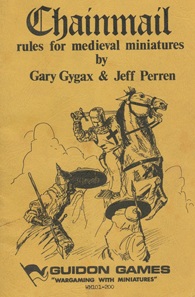

Source: Wikipedia
Dungeons and Dragons – and thus the entire RPG hobby – has its roots in historical miniature wargames. In fact, until Advanced Dungeons and Dragons, D&D rules referenced Chainmail and strongly suggested the DM have a copy. Way back in 1968, a guy named Gary Gygax attended the first Lake Geneva Wargames Convention (something familiar about the name?) and watched a session of Henry Bodenstedt’s Siege of Bodenburg, an early medieval minis wargame – and became an enthusiast of the hobby. Paralleling the experiences of many current game developers and writers, Gygax turned pro. By 1970, he was creating wargames for Guidon Games. Guidon’s first products in 1971 included first edition Chainmail by Gary Gygax and Jeff Perren, based on Gygax’s articles for several wargaming magazines.
Yes, in Chainmail you can find the origins of some D&D mechanics. There was a “Dungeon Master” of sorts in Chainmail‘s castle siege mechanics. An impartial referee was needed for scenarios involving underground mining and countermining operations. My husband, Mark, says this “DM” was used for any type of what he calls “fog of war” situations; that is, where “one side doesn’t know what the other is doing.” Appendix B, tables to be used with the “Man-to-Man Combat” chapter, look familiar to many “old school” D&D players (which includes me, since I got into RPGs with AD&D). The 8 types of armor (non-horse) in the Man-to-Man Melee Table are very close to those in original D&D and AD&D (No Armor, Leather/Padded, Shield…Plate Armor and Shield). In fact, the Individual Fires With Missiles Table is labeled along the top, “Class of armor worn by defender.”
Gygax wanted the flavors of both Howard’s Conan the Barbarian and Tolkien’s Middle Earth. This lead to the last, and last-written part of the rules, called the “Fantasy Supplement.” In addition to organization and equipment tables based on real history and artifacts, Chainmail included the “Fantasy Supplement” so that players wanting to change up their sessions could do battle with fantasy archetypes and monsters, including heroes and magic swords, spell-wielding wizards and, of course, dragons. Speaking of spells, the 16 spells and two types of (magic) missiles available to wizards are all familiar to D&D players – Cloudkill, Phantasmal Force, Fireball (missile), Protection from Evil, etc.). But there were no giants or magic armor until second edition.
In spite of the “Fantasy Supplement,” Chainmail is a tactical level simulation wargame even when using the Fantasy options. Even the “Man-to-Man Combat” mechanics use a figure:men ratio greater than 1:1 (meaning each miniature represents more than one combatant, usually 20 in Chainmail). So, according to Mark, the Chainmail game play experience is much more like playing Warhammer Fantasy Battles than playing D&D. So no roleplay as we think of it.
Now the innovation that truly paved the way for RPGs was not one of Gygax’s creations. In traditional minis wargaming, one miniature represents multiple “men,” and Chainmail was no exception, using a figures:men ratio of 1:20 for 25-40mm minis. Dave Arneson (sometimes spelled “Arnenson”) did Chainmail games where each mini represented a single “Character.” Writing in Best of Dragon Volume 1, Gygax describes playing in Arneson’s Chainmail sessions and later receiving “18 or so pages of handwritten rules and notes” which would be incorporated into D&D.
Order of the Stick creator Rich Burlew charmingly (and no doubt very loosely) recounts this in his 2009 “Order of the Stick #644” tribute to Arneson, upon his passing, as:
“And the Creator of the Game looked down upon the troops and saw that they were fun but could be more fun.
“He gathered his companions together and said ‘Lo, each of you shall command but one figure, which shall be called thy character…Look we’re not doing a big battle, OK? This is something new. Just–just trust me guys. It’ll be fun.’
“…And it was fun.”
Yes it was fun, we’re still having fun, and it all started with Chainmail.
Credit: Thanks to my husband, Mark Whitson, who has Chainmail and still speaks fondly of it. He told me about the Chainmail play experience, provided most of the information on how close it was to D&D, and clarified/verified the information I found on it.
References: Chainmail, first (Guidon Games) and third (TSR) editions (out of print)
“Discover Chainmail, Gary Gygax’s Dungeons and Dragons Prototype”
Order of the Stick #644, copyright 2009, Rich Burlew
Linda Whitson
Latest posts by Linda Whitson (see all)
- Astral Projections – The Ripperdoc Is In - May 8, 2023

Thanks for the history story Linda! So many interesting stories in the history of gaming. That Arnenson character is ever the mysterious shadowy character in RPG history.